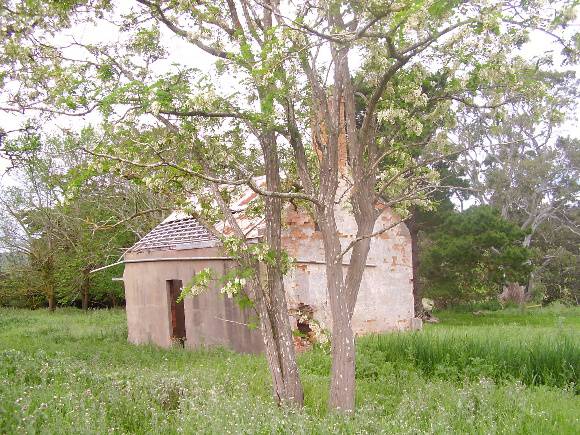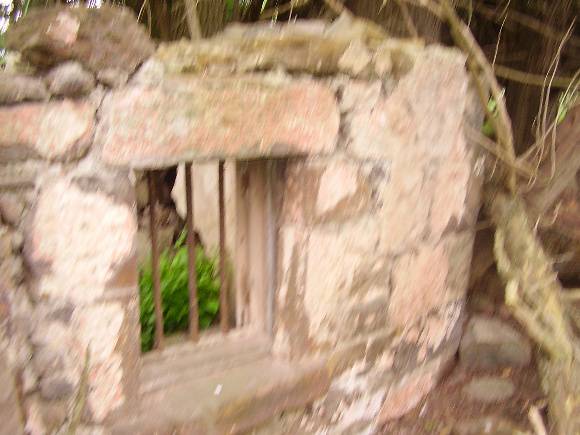| Back to search results » | Back to search page » |
|
WANDO VALE HOMESTEAD SITE
Location366 CASTERTON-EDENHOPE ROAD, WANDO VALE, GLENELG SHIRE LevelRecommended for Heritage Overlay |
|
Statement of Significance
What is Significant?
The Wando Vale Homestead site is located on the east side of a hill, between the Casterton-Edenhope Road and Hardie's Road, approximately 500m south east of the intersection of the Satimer Road and the Casterton-Edenhope Road. The physical fabric which remains of this once substantial homestead complex is limited, but can provide some understanding of the lives of the earlier occupants and owners. The cellar and store house ruins are the only part of the main house which is relatively intact. The walls of these are constructed with sandstone and iron stone blocks, which have been worked with a substantial degree of skill, particularly those on the facade of the building. The windows are small openings in the walls with iron bars across them. The original homestead probably dates from the 1840s. To the south west of the main homestead ruins, a small brick outbuilding survives. The bricks appear to be handmade, and the outbuilding may date from as early as 1860. It has had a significant amount of the structure to the northern end removed. The building appears to have been a kitchen (perhaps a detached kitchen to the main house, or a workmen's kitchen). It has a large open fireplace, used for cooking, with hooks and holes for placing cooking equipment and a bread oven to one side (now bricked up). The interiors show a variety of different wall coverings, from white and green lime wash through to vivid turquoise. The building has two large rectangular window openings, one on the east and one on the west side of the building. The window on the west side has the remains of a four paned window, the window on the east has the remains of a twelve paned double hung sash window. An exterior door is located to the north of the window on the east side of the building. It appears that the rear (north) part of the building has been recently demolished, as what appears to be an internal door leads to the north exterior. The northern facade is rendered, and shows clear evidence of a division between two rooms. Unusually, the south side of the building shows an entrance into the ceiling, similar to a loft door opening. The structure is in poor condition. Thereis limited remaining of the once extensive garden. This has been severely exacerbated by recent removal of the fencing which appears around the homestead site in the 1990s. The trees which remain include Robinia pseudoacacia (Wisteria tree), Ulmus procera (English Elms), Cupressus macrocarpa (Monteray Cypress), Cratageus monogyna (Hawthorn), Laurus nobilus (Bay Laurel), Pinus radiata (Monterey Pine), and it is likely that a number of bulbs and other small shrubs survive, which were not evident at the time of inspection. A River Redgum which is located immediately in front of the main house site may be one planted in the 1840s in Robertson's very early 'native' garden plot. The trees which do remain are generally in good condition, and provide some understanding of the extent of layout of this once famous garden.
How is it Significant?
Wando Vale Homestead Site is of historical, architectural and botanical significance to the Glenelg Shire.
Why is it Significant?
The Wando Vale Homestead site is of historical significance firstly as the home of the prominent landholder, botanist, naturalist and writer, John George Robertson, who established Wando Vale run in March 1840. Robertson was one of the first four squatters to come to the Western District, and his written record of the changes which he saw over the period of his occupancy on his and others' land provides a lasting primary source detailing the speed at which early pastoral practices destroyed the very land it had cherished. The garden which Robertson established at Wando Vale is of extremely high historical and botanical significance. It was started in 1841, and was planted out with fruit trees, vines and brambles, all grown from seeds collected from Van Diemen's Land specimens as well as from England, and sources such as the seeds of barreled apples sent from England. The trees were established in the same way, or from cuttings of plants from visiting officials, and eventually neighbouring runs. Of further interest was the 'native' collection which Robertson grew. As a botanist, Robertson collected samples, seeds and plant material of indigenous flora around the area, and planted these out on the creek bank. It is possible that the only remaining plant is the surviving River Redgum in front of the main house site. The plants which remain in the garden represent an early and semi-professional attempt at botanising and establishing new and recognised plants in a foreign land. The ruins of the house are of architectural significance for their simple solid construction, and fine stonework, using local stone and timber, as well as hand made bricks constructed from the clay of their nearby creek or the Wando River, some 2 kilometres away.
Group
Residential buildings (private)
Category
Homestead building






